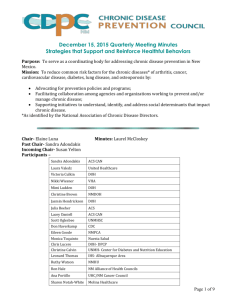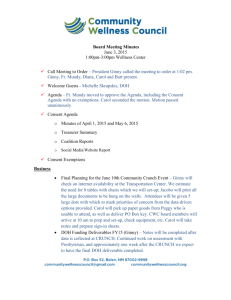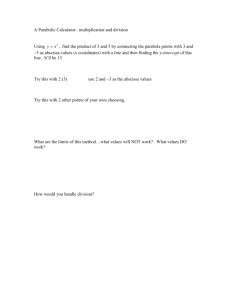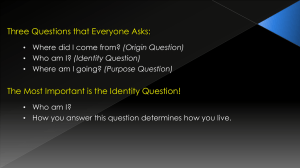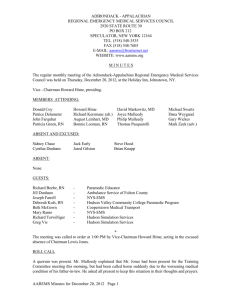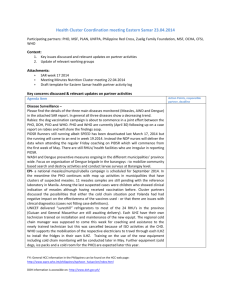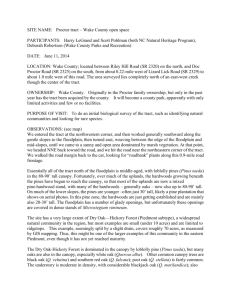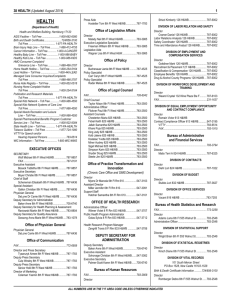Probability solutions 22 Feb 2014
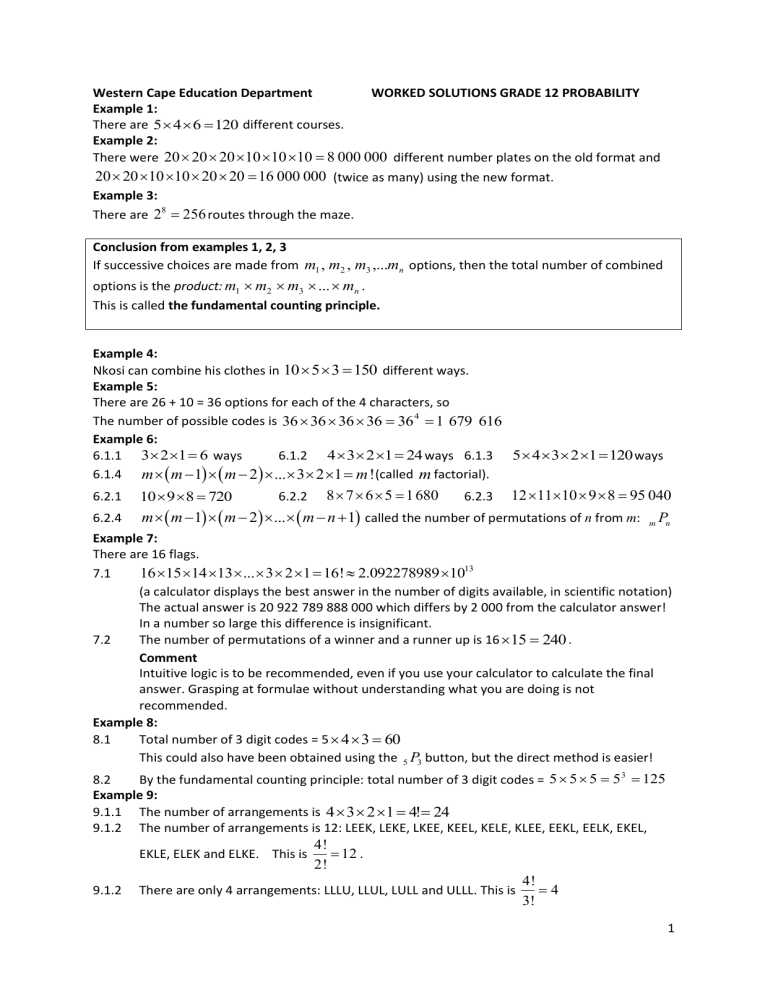
Western Cape Education Department
Example 1:
WORKED SOLUTIONS GRADE 12 PROBABILITY
There are 5 4 6 120
Example 2:
different courses.
There were 20 20 20 10 10 10
8 000 000 different number plates on the old format and
(twice as many) using the new format.
Example 3:
There are 2
8
256 routes through the maze.
Conclusion from examples 1, 2, 3
If successive choices are made from m
1
, options is the product: m
1
m
2
m
3
...
m
2
, m n m
3
,...
m n
.
options, then the total number of combined
This is called the fundamental counting principle.
Example 4:
Nkosi can combine his clothes in 10
5
3
Example 5:
150 different ways.
There are 26 + 10 = 36 options for each of the 4 characters, so
The number of possible codes is 36
36
36
36
36
4
1 679 616
Example 6:
6.1.1 3 2 1 6 ways
6.1.4 m
m 1
m 2
6.1.2 4 3 2 1 24 ways 6.1.3
ways
... 3 2 1 m !
(called m factorial).
6.2.1
6.2.4
10 9 8 720 m
m 1
m 2
6.2.2
...
m n 1
6.2.3 12 11 10 9 8 95 040
called the number of permutations of n from m : P m n
Example 7:
There are 16 flags.
7.1
13
(a calculator displays the best answer in the number of digits available, in scientific notation)
The actual answer is 20 922 789 888 000 which differs by 2 000 from the calculator answer!
In a number so large this difference is insignificant.
7.2 The number of permutations of a winner and a runner up is 16
15
240 .
Comment
Intuitive logic is to be recommended, even if you use your calculator to calculate the final answer. Grasping at formulae without understanding what you are doing is not recommended.
Example 8:
8.1 Total number of 3 digit codes = 5
4
3
60
This could also have been obtained using the
5
P
3 button, but the direct method is easier!
8.2 By the fundamental counting principle: total number of 3 digit codes = 5
5
4
3
2
1
5
5
3
125
Example 9:
9.1.1 The number of arrangements is 4 !
24
9.1.2 The number of arrangements is 12: LEEK, LEKE, LKEE, KEEL, KELE, KLEE, EEKL, EELK, EKEL,
EKLE, ELEK and ELKE. This is
4!
2!
12 .
9.1.2 There are only 4 arrangements: LLLU, LLUL, LULL and ULLL. This is
4!
4
3!
1
9.1.3 Where there are 2 Ls and 2 Us, there are 6 ‘words’ that can be formed:
LULU, LUUL, LLUU, ULLU, ULUL and UULL. This number is
4
2 !
!
6
2 !
In general, the formula for the number of different ways that n items can be arranged, where r
1
of the n are identical items of one type, r
2 of the n are identical items of a second type, r
3
of the n are identical items of a third type and so on… is r
1
!
r
2
!
n !
r
3
!
...
Example 10
10.1 The number of ‘tunes’ is the seven different notes in order.
By the fundamental counting principle: 7
6
5
4
3
3
2
1
7 !
5 040 . Notice that once the first note has been ‘chosen’ from the 7 notes, there remain only 6 notes from which to choose the second note in the ‘tune’, and then only 5 notes remain from which to choose the third note… and so on.
10.2 The number of ‘tunes’ is 7 7 = 823 543. This time, there is a choice of all 7 notes for every note in the ‘tune’. This means that doh, doh, doh, doh, doh, doh, doh is a ‘tune’, so is doh, fah, me, re, doh, so, doh.
10.3 The number of ‘tunes’ is 1
7
7
7
7
7
1
16807 as there is only one way of choosing the two dohs at the start and end of the ‘tune’.
10.4 There are 7 notes. Doh is repeated 3 times, me is repeated 2 times and so is repeated 2 times, so the number of ‘tunes’ is
3 !
7 !
2 !
2 !
210 as repeating notes in a tune is the same as repeating letters in a word.
Example 11:
8 !
11.1 There are 8 letters: 3 Us, 2Ns and 2Ds. So number of different words =
3 !
2 !
2 !
1 680
11.2 If we take one of the Ns for the first letter, there are 7 letters left, of which 3 are
7 !
Us and 2 are Ds. Hence the number of words =
3 !
2 !
420
11.3 If we take both Ns for the first and last letters, there are 6 letters left, of which 3 are Us, and 2 are Ds. Hence the Number of words =
6 !
3 !
2 !
60
Example 12:
12.1 4! 24 12.2
4!
2!
12 12.3
6!
2!
360
12.4
6!
180 12.5
9!
45 360 12.6
9!
30 240
Example 13:
Let the event that the word randomly generated starts with ‘H’ and ends with ‘Y’ be E. The sample space S is all the possible permutations of the letters of the word HISTORY.
2
The number of ways the 7 letters of the word can be arranged is n(S) =
7
P
7
7 !
To calculate the number of ways the event E can occur, we need to remember that the ‘H’ and ‘Y’ are fixed, so we have H _ _ _ _ _ Y. Hence n(E) =
5
P
5
5 !
The probability that a randomly generated word will start with ‘H’ and end with ‘Y’ is thus:
P(E)= n ( E ) n ( S )
5 !
7 !
1
42
0 , 023 ...
You may be tempted to reason as follows:
1
The probability that the first letter is a ‘H’ is
7
and the probability that the last letter is an ‘Y’ is also
1
, so P(E) is
1
1
1
0 , 020 ...
7 7 7 49
This is incorrect as the assumption has been made that the two elementary events of drawing an ‘H’ and then drawing a ‘Y’ are independent, but they are not because once the ‘H’ has been drawn the probability of drawing the ‘Y’ is greater since the sample space is now smaller.
With or without a tree diagram, the solution can be calculated as follows:
1
P(drawing the ‘H’) =
7
1
. Once the ‘H’ has been drawn, P(drawing the Y) =
6
, hence
P(E)=
1
1
1
42 7 6
Example 14
In this example, letters and digits can be repeated.
14.1 Let E be the event that a number plate starts with a ‘B’ and ends with a five. We are looking for something like this: BRR 615.
Since 20 letters and 10 digits can be used, we calculate: n ( S )
20
20
20
10
10
10
8 000 000 n ( E )
1
20
20
10
10
1
40 000
P ( E )
n ( E ) n ( S )
40 000
8 000 000
1
200
0 , 005
This can also be done using the following logic:
P(choosing a ‘B’) =
1
20
1
and P(choosing a five) =
10
.
Since these are independent events,
P(E) = P(choosing a ‘B’ and a five)= P(choosing a ‘B’)
P(choosing a five)
=
1
20
1
10
=
1
200 .
5
10
3
0 , 005
14.2 Let the event of exactly one B being chosen be A. This B could be the first or the second or the third letter in the number plate. In each case, the other letter must not be a
‘B’ but one of the other 19 letters.
There are 10
10
10 ways of choosing the three digits and this number ( 1 000) must be multiplied by the number of ways that there can be exactly one ‘B’.
This B can be the first letter or the second letter or the third letter.
There is 1 way of choosing a B for the first letter and 19 ways of choosing the other two letters: ( 1
19
19 ) .
This must be added to the number of ways of choosing a letter other than B, then a B and then not a B and then a B
19
1
19
19
19
1
and the number of ways of choosing a letter other than a B twice
.
3
These numbers added together must be multiplied by 10
10
10 = 1 000.
So: n(A) =
P ( A )
10 n
10
n
10
1
8
083
000
1
19
000
000
19
0 , 135
19
375
1
19
19
19
1
1 083 000
14.3 Let the event of at least one 5 being chosen be C
This problem is best solved using the fact that P(C) = 1 - P( C
) where
(the complement of C) is the event of not getting a single five.
P ( C )
1
P ( C
)
1
20
20
8
20
000
9
000
9
9
0 , 271
C
Example 15:
STATISTICS has 10 letters. It consists of 3 Ss, 3 Ts and 2 Is, an A and a C. To find out how many possible arrangements of these letters there are, we use the formula: n ( S )
10 !
3 !
3 !
2 !
(10 letters of which there are 3 Ss, 3 Ts and 2 Is)
= 50 400
If E is the event of the word starting and ending with the same letter, then we are looking for S_ _ _ _ _ _ _ _ S or T_ _ _ _ _ _ _ _ T or I_ _ _ _ _ _ _ _ I
Then n(E) = number of words using the letters TATISTIC (excluding the two Ss at the start and the end of the word) + the number of words using SATISICS (excluding the two Ts at the start and end of the word) + the number of words using the letters
STATSTCS (excluding the two Is at the start and end of the word)
3 !
8 !
2 !
7 840
(3 Ts and 2 Is) +
3 !
8 !
2 !
(3 Ss and 2 Is) +
8 !
3 !
3 !
(3 Ss and 3 Ts)
So the probability of the rearranged letters starting and ending with the same letter is:
P ( E )
7 840
50 400
0 , 1
Alternative method:
P(choosing an ‘S’)
3
10
because 3 of the 10 letters are Ss.
The probability of choosing a second ‘S’ is not independent of whether or not an ‘S’ was chosen on the first draw:
2
P(choosing a second ‘S’ once it is known that the first letter drawn is an ’S’) =
9
.
4
Similarly, as shown in the following tree diagram, the probabilities of the successive events, of drawing one and then another ‘T’ and one and then another ‘I’, which are not independent, can be calculated:
So P ( E )
3
10
2
.
9
3
10
2
.
9
2
10
.
1
9
0 , 1
5


